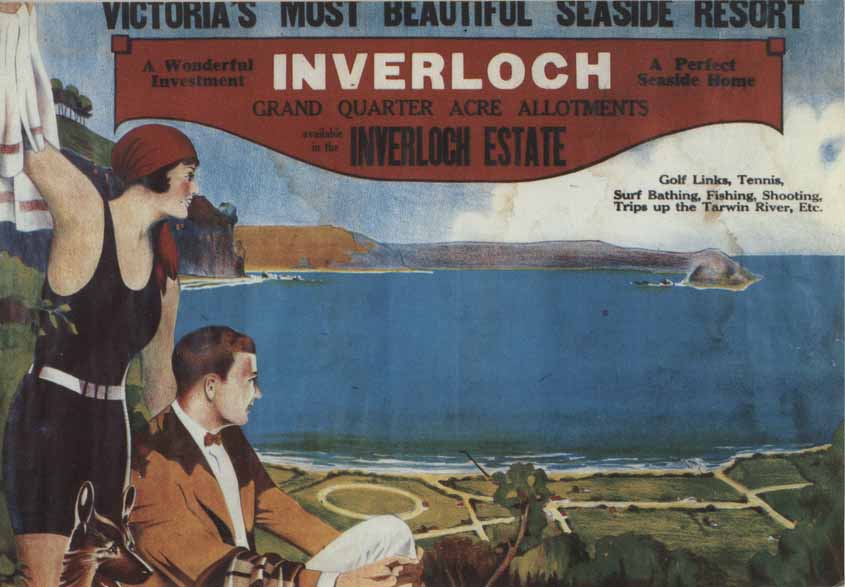The story of the development of a small section of Inverloch over a period of 75 years as told by the participants.
Foreword
This book is one of a series of books on the history of Inverloch to be published by the Inverloch Historical Society over the next few months.
The material consists of talks given to the Society by “old identities ” closely associated with the events they describe.
The people residing in Inverloch have since 1888 consisted of full time residents and those with holiday homes.
Socially, the town divided into permanent residents, visitors who lived east of Williams St and visitors who had houses on top of the “hill”. These stories are about two families, Chambers and Grieve (Stirton) who started coming to Inverloch for holidays 75 years ago and have continued every year since.
These stories also describe the hard life endured by the Scottish & English migrants in the 1920 ’s and the very strong social conscience of the miners of the Wonthaggi coal field and the role played by their wives.
We propose in later publications to illustrate the development of other areas and the role of other groups.
K.G. HOWSAM
President, Inverloch Historical Society
Memories Of Inverloch: 1925 & Beyond
ADDRESS by JOE CHAMBERS to the INVERLOCH HISTORICAL SOCIETY on 24th July 1996
In 1925 I was a wee boy just out from Scotland, about 9 years of age! Much of my information concerning times prior to 1925 was obtained from Charlie Street who died in 1984. Charlie Street, a bullock driver and timber worker, first came to Inverloch in March 1909 from Tangambalanga (near Kiewa) Vic. This involved a rail to Stony Point, ferry to San Remo, coach Price’s Corner (now Dalyston) and by walking to the Griffiths property near what is now the eastern end of White Road Wonthaggi and from there to the Inverloch road at somewhere near what is now Metherall’s property. This was the droving road.
A second road, which was the coal road for about 10 weeks, followed a track south of the present road, past Dr Joyce’s house, Foster’s farm and reached the pier down Pier Road.
My first visit to Inverloch was in a two horse drag for a Sunday School picnic in April 1925. The picnic was held on an open space between Bayview Ave. and Hopetoun St. there were cows wandering about and they kept the grass short and green.
Later in 1925 we camped at what is now 10 Grandview Grove. At that time there was only one house in the area which belonged to Paddy Webb the publican of the Caledonian Hotel in Wonthaggi. The house was in Pier Rd. on the east side opposite the end of High St.
Looking North from Paddy Webb’s house to the Tarwin Road was only one house, “Canary Cottage”; the rest was trees and scrub. Looking towards Bayview Ave was open land which we used as a cricket pitch, whilst towards Beilby and Pymble Avenues were Darling’s and Cuttriss’s farms.
There were a few houses in High St.. Those of John Muldoon, a bullock driver and Russ Jacobson who had cows and sold milk come to mind.
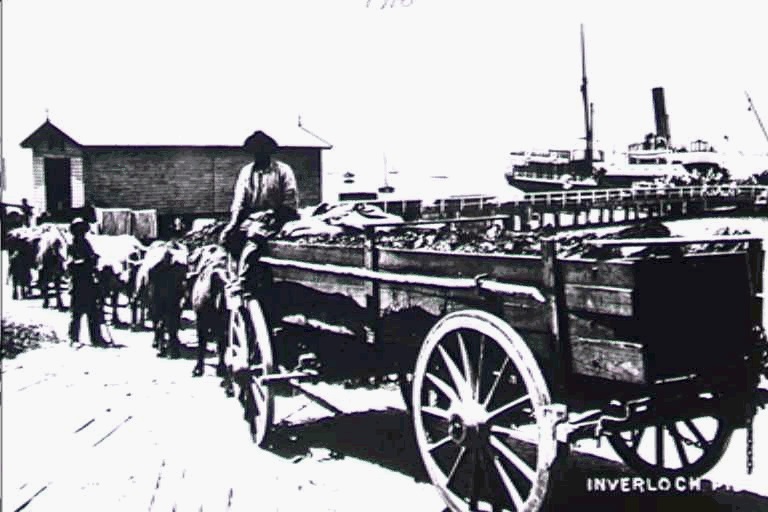
(Photograph from the collection of the Korumburra & District Historical Society)
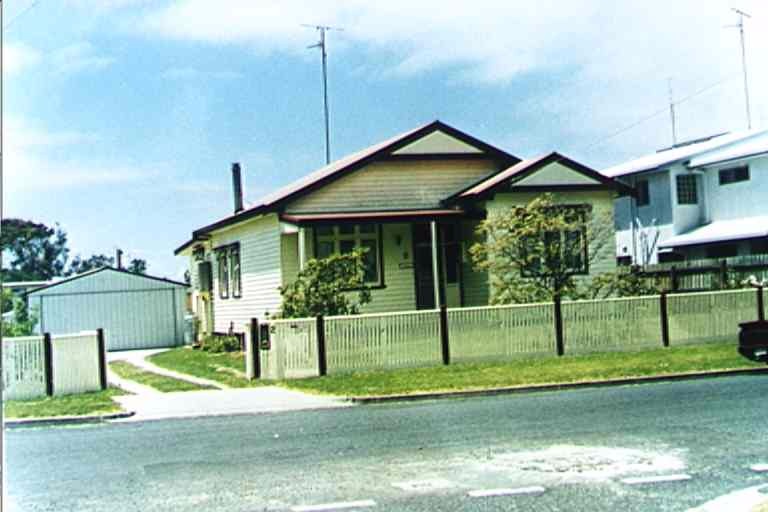
Hopetoun St. ended at Pier Rd. where there was a well. Here were holiday houses belonging to Joe Kidd, a Wonthaggi builder and to Joe Meredith, a dentist.
The foreshore opposite the well was of deep sand and was used for camping. There were many large banksia trees and the area was known as Lovers’ Lane. There was a left hand turn into Darling’s farm where people used to camp in one of his paddocks and I believe he used to let rooms.
It was not possible to get through to Screw Creek except along the beach where there were some squatters huts one of which was shifted to 6 Grandview Grove.
This is Nancy Stirton’s house but originally it belonged to Mr. Simcox a saddler from Wonthaggi who had a very fine gig equipped in the American fashion with 2 chestnut horses – a very fast and spectacular rig ! This house still stands and you will note that it is built right up to the footpath line as at that time the blocks and streets were not marked out..
We camped on the site of 10 Grandview Grove. We would arrive equipped with two hessian bags and our first task was to cut teatree leaves to fill the bags which were then stitched together to make a mattress. If one was lazy and cut too far up the branch then the twigs would make their presence felt at night especially if one was sunburnt.
The estate agent advised us that we were on private land and offered us the property for £50. We paid £5 deposit, a very large sum in those days, and we built a hut and later other buildings.
So far I have concentrated on the south eastern corner of Inverloch and I will now shift my attention to the main part of town which was very different then to what it is today. In a’Beckett St. were shops; Holmes store which consisted of general country store, groceries, bakery in the rear and a post office next door.
Bank’s butcher shop was on the other side of the road.
The hotel was on the corner as at present and of wooden construction. There were no shops in William St. but I can recall a large square tank with the side out of it opposite the hotel
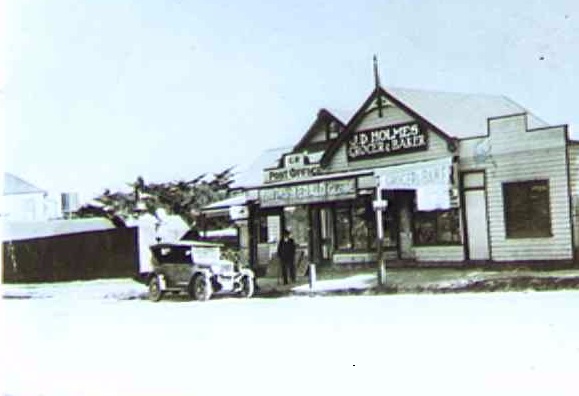
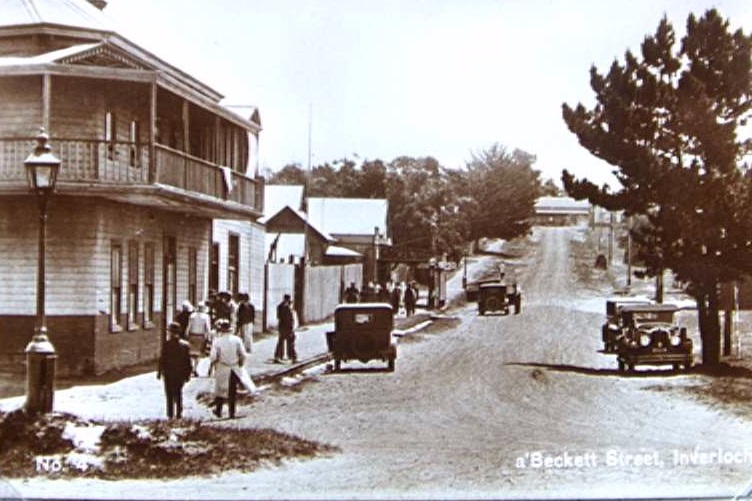
On the site of the present “Inverloch Marine Centre” was a garage with a shop and a billiards room which was conducted by Hans Fischer.
It is rumored that during the war , I am not sure which one, Hans Fischer used to take 44 gallon drums of petrol out to sea and refuel enemy submarines and hence the origin of the name “Petrol Rock”.

A little further down was the rocket shed, I never did find out what was inside as it was always locked.
Once the Manawatu got stuck on the bar and the rocket crew went out in a tender but got into trouble and had to be rescued by the crew of the Manawatu.
Another story is that the rocket crew were practicing in the front garden of the house of the Harbour Master, Mr. Henderson, on the corner of Williams and High Streets, a rocket was accidentally ignited and went straight through the house and out the back door without causing much damage.
Further down The Esplanade, opposite the Yacht Club was a shop conducted by Mary Mountain who later became Mrs. Bill Ramsay. Her father was a bullock driver. There was also a shop with a dance floor – Donohue’s (Nelson’s). Opposite the bowling club was another lolly shop run by Richards
The jetty was larger than at present with a Ports and Harbours’ shed at its commencement. There was a trolley on iron rails which brought goods from ships to the shed for storage until collected by the consignees. Carts could be loaded from the end of the shed which opened onto The Esplanade. Attached to the shed was a glassed in area which contained a barometer.
Next to the jetty was an iron shed which was used as a change room. The young bucks used to change after work and run down the pier and dive over the end into deep water. One day there was a rowing boat anchored in front of the pier and the diver was just able to deflect the boat with his hand and thus avoid a nasty accident.
Opposite the jetty was a house owned by Gidney, the mine manager. Tides were sometimes very high and on one occasion reached Paddy Webb’s house
Returning to a’Beckett St. and looking up the hill one could see Two Views Guest House on the top of the hill. Just past Reilly St. was the Mechanics Hall with a library (Carnegie Bequest) and next to it a church. On the left hand side were 1 or 2 houses and Sparks butcher shop where the Leongatha Surgery is now.
The Crescent was gravelled, but Sandymount Ave was not made and was just a track. Ramsay Boulevard was a track. Scarborough St. had a few houses. In Venus St. were a number of houses including that of Brunt, a solicitor from Wonthaggi: the Brunt’s used to come at Christmas and remain until Easter.
Bill Young lived at the end of Abbott St. He came from Waratah Bay and story has it that he was first seen sailing straight over the bar at high tide towards the beach at Abbott St. When asked later why he came in like that, Bill said, “I would have sunk otherwise.”
Memories Of Inverloch: 1930 – 1940
ADDRESS by BILL GRIEVE to THE INVERLOCH HISTORICAL SOCIETY on 27th May 1998
My memory is of Wonthaggi in the 1930’s and of the close association of my family with that of the Chambers family at Grandview Grove, Inverloch
We came from England in 1926: grandmother, mother, three aunties and an uncle and me.
Our story has been documented by Angela Stirton in her book “Nancy’s Story”, an abridged version of which is appended.
Living in Wonthaggi the highlight of the year was the annual trip to Inverloch. The trip was by the bus which was used to take the miners to the various mine shafts in Wonthaggi; it was owned by the Rogers brothers. The bus was hired by three families , the Chambers, Enterkins and the Grieves. The bus started at the Chambers house – a three acre block, collecting the families and their belongings including mattresses and bedding. It would continue picking up the other families and their belongings, the younger members sitting on the mattresses at the back of the bus with their heads almost touching the roof. It was always a sing-a-long conducted by the musical Chambers family.
The arrival at Inverloch was like a trip into the unknown.
The township virtually finished at Williams St. with a track along Bayview Ave. to Pier Rd. which ran down to the pier. The streets, basically tracks, finished at Pier Rd. These were Hopetoun St., High St. and the Esplanade. This area was well populated with local people.
Our destination was across a paddock to a tea-tree covered block owned by the Chambers family which is now 10 Grandview Grove!
The block had a small two roomed hut, known as “The Barn”, and several tents to accommodate approximately 20 people. Part of the hut still remains.
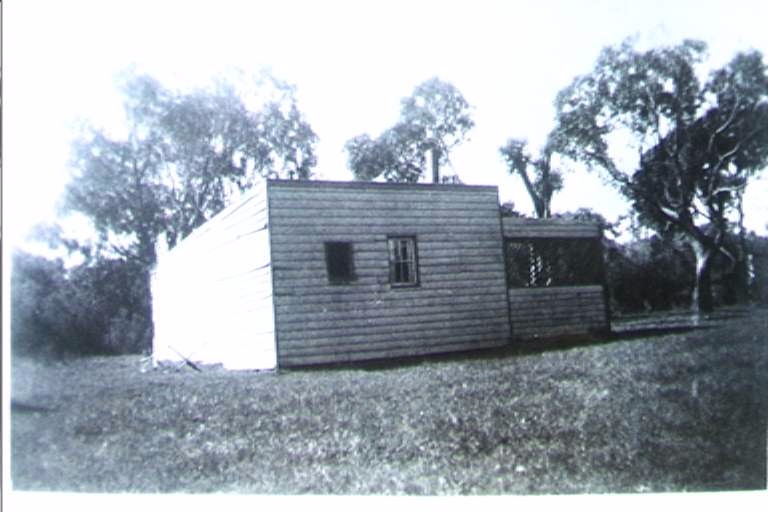
Life was pretty primitive as there was no electricity and limited water from a small tank.
The duty of the younger members was to carry water in a kerosene tin from a well which was situated at the bottom of Hopetoun St.; and, if this was unavailable, then it was a trip to the Mechanics Hall: not a popular chore but it had one good aspect – no washing for the duration.
Another duty was to go for the milk which was supplied by the Jacobson family who had a small farm and dairy in High St.
Mr Jacobson was also a professional fisherman.
Over time there were building extensions, the Grieves family building a hut at 6 Grandview Grove and the Enterkins building a hut at the rear of the Chambers block.
At this stage there were a few huts along the foreshore, which the Foreshore Committee decided had to be removed.
The Grieves family purchased one of these huts belonging to the Simcock family for £50 including a small wooden dinghy. The hut was transported with great difficulty through the bush to 6 Grandview Grove.
When the road was later made it was found that the house was only six inches from the footpath. The building still exists although it has been built around and over since.
Another hut I remember was one owned by the Stirton family on the corner of Venus St. and Ramsay Boulevarde under a large gum tree.
The police station at this stage was in Hopetoun St. later moving to a’Beckett St, and finally to Bayview Ave.
The business area of Inverloch consisted of a hotel – still on its original site, Holmes general store and post office on the site of the Riteway store, Banks Bros. butchers on the corner of Reilly and a’Beckett Sts.
In Williams St. was Ramsay’s general store and another Banks Brothers butcher shop where the Surf & Ski shop is presently located in the original building.
Along The Esplanade side near where Inverloch Marine is now, was a bakery and billiards room owned by Mr. Hans Fischer, later there was a milk bar on this site.
On the left hand side of the road looking down to the pier was a milk bar and cafe run by Mrs. Johnson and later by the Azzopardi family.
Further down near the entrance of the bowling club was the Tarax Bar at the rear of which was a small hall which was used for dances and other entertainment; this was run by Mrs. Donohue and later by the Nelson family, further down near the pier was a sweet shop run by Mrs. Mathison. At a later date a store was opened just past the pier by Mr. Hitchens known to everyone as “Pop”.
The pier was a focal point of the beach.
My earliest recollections of the pier are that it was where The Esplanade now is. At the start was a galvanised sheet shed which was used for storage.
This shed was similar to another in the vicinity of the Yacht Club; known as the Rocket Shed, which has been well documented in the books of the history of early Inverloch.
In my early days I have recollections of water at the start of the pier at high tide, at times flowing through a depression all the way to Hopetoun St.
The original pier had rail lines for a trolley that ran to the end of the pier to a rather large hand driven jib crane which was used to load and unload ships. During my early days it was seldom used except by the braver youths as a diving tower.. Alongside the pier at approximately the site of the bowling club was a bathing enclosure which was in a state of decay and has since gone. Since then there have been many extensions and rebuilding of the pier in vain attempts to reach a deep water channel. The original pier finished approximately at where the toilets are now.
The accommodation for holiday makers was camping on the foreshore, the hotel, Two Views guest house run by the Horrocks family and Pine Lodge which offered five star accommodation. During the war Pine Lodge became a Naval Hospital. After the war it failed to recover its former glory.
New Year’s Day was the highlight of the Christmas period with a Carnival held in a fenced off area of the beach; us kids always found a way of getting in for nothing as we could not afford the entry fee. The Carnival attracted large crowds from all over Gippsland. The main attraction was the Miss Inverloch beauty contest. Another attraction was Briggs Carnival which was situated on the site now occupied by the Inverloch Marine Centre.
There were ferries that travelled across and around the Inlet. One I recall was named the “Beryl” and was owned by a local fisherman, the late Mr. Bill Young.

One of the most popular trips was to take the ferry to the other side of the inlet opposite Townsends Bluff: Near the jetty was a small park which was very popular with people who did not want to venture to the surf beach.
Another event was a camp fire at the Cuttriss farm on the Esplanade, its boundaries were roughly Beilby Ave., Inverloch Parade and Cuttriss St. The farm house still exists but has been modified over the years, it is on the bend of Beilby Ave.
In recalling these memories I realize how fortunate I was to be able to spend carefree and happy school holidays for many years at Inverloch.
The tradition of meeting at Inverloch for Christmas still carries on among families, especially the Chambers family whose midnight gathering on New Years Eve has been held on the same block for over 70 years, with five generations of the family in attendance during that time.
Nancy’s Story by Angela Stirton 1944.
An abridged version
On November 11th 1925, my father William Paterson Grieve passed away. For many days my mother had nursed him in our home in Ashington, England, where he had developed a heart condition after suffering scarlet fever.
Our family was very saddened by my fathers death, and we were uncertain of the direction our lives would now take.
Tom, my eldest brother, had received a mine manager’s certificate at school, and was at this time living in Australia; and, he insisted that we all come out to Australia, and he then nominated us to do so.
In March 1926 we went to the dock to board the boat to come out to Australia. My elder brother Harry, aged 24 stayed behind, as he had a steady job and chose to be with his girlfriend. But because Tom did not know of the arrival of Billy, he had not nominated him and the officials would not allow Billy onto the boat.
Finally, after a great deal of persuasion, Nanny, Emily aged 26, Bob aged 17, Nellie aged 12, Bessie aged 6, baby Billie and I who was 14, all boarded the boat for Melbourne, Australia.
On the boat we were forced to share a cabin containing four bunk beds between the seven of us.
The boat made a stop at Freemantle, in Western Australia, and we visited Nanny’s sister Emily. Aunty Em gave us some jars of home made fig jam, which I thought was wonderful.
Finally, in May 1926, after six long weeks on the boat, we arrived at Station Pier, Melbourne.
We caught a train from Melbourne down to a small coal mining town called Wonthaggi where Tom was anxiously awaiting our arrival. With all our bags and belongings, we walked from the train station all the way to Merrin Crescent. Tom took us to Granny Chambers’s house, where we were made feel more than welcome.
Granny was a good friend of Tom’s and they were both members of the local debating society. Granny Chambers filled our empty stomachs with a beautiful dinner. After dinner, Tom took us to the place in which he lived.
Tom’s place was a small wooden house with three bedrooms, a table and chairs and large meat safe in the centre of the room. In the bedroom were I slept, there was a case full of apples, which I thought had the most loveliest smell.
In the first week we lived in Wonthaggi, the miners were on strike. The strikers would go out near the cemetery and chop fire wood. We all used to go along and help. In those days, you could buy two loaves of bread stuck together, and you had to tear them apart. When we had finished chopping wood we would go home and eat a whole loaf with Aunt Em’s beautiful fig jam on it.
As the days past it became more obvious that the eight of us plus Tom were much more than the small wooden house could hold. Tom arranged for us to move into and run a boarding house. The boarding house was situated in McBride Ave., next door to the Sentinel office. We had ten men living in the boarding house, and they would each pay Nanny thirty bob per week. Things would often get pretty rough around the house, and the men would pinch anything they could get their hands on. The men would often gather together and tinker around with old engines and machinery, and as men do, and they would quite often curse and swear when things wouldn’t run smoothly. Billy, who was only young at the time, would join the men in their antics and could swear just as well.
At this time, both Nellie and Bessie attended the local school, but I had to stay home and help Nanny. I had to wash all the sheets in a copper, wash all the floors, wash, starch and iron all the table cloths and make all the beds.
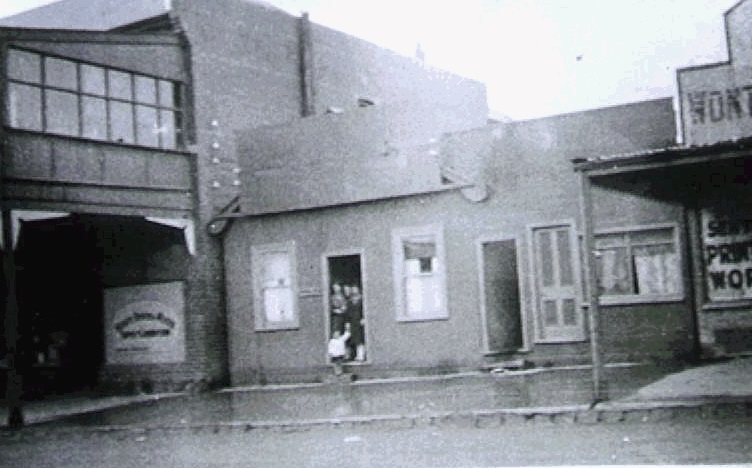
Stirton Boarding House. McBride Ave, Wonthaggi c1928 (Photograph supplied by Bill Grieve)We had, one pan toilet, and the men had a urinal behind an old tin fence. We had an old tin bath, which had to be filled with water boiled in the copper. The kitchen was galvanised iron with dirt floors, no sink or running water and we only had wood stoves to cook on. The dining table was five yards long, and despite the hardship, Nanny would turn out beautiful meals.
Due to its poor conditions the boarding house did not meet the health regulations, and the Health Department was forced to close it down.
Now without an income, we found ourselves taking a new step and we moved into a shop which was located across the road from the Union Theatre.
We sold pies, pasties and fish and chips. It was my job to peel all the spuds by hand and fry the chips in a big iron boiler. I had then to bone all the fish, and I loved it when we bought gummy sharks for five shillings, because they had no bones..
During the depression, kids from the Tech school would come to the shop and ask for a threepeneth of chips. The really poor kids would ask for a peneth of chips and then ask if there were any stale pies or pasties.
Bill Chambers would come to the shop and sit and help me peel all the spuds, in those days potato peelers did not have a swivel blade and were only suited to right handed people.
Bill being left handed struggled with the peeler, and I can still picture him awkwardly (sic) peeling the spuds in a backwards direction. I do not think I would ever have gotten them all peeled if it wasn’t for Bill ! Bill and I were very much in love, and he was very special to me.
One day when I arrived back at the shop, after getting mince for the pies, Nanny was standing in the doorway waiting for me. She told me that something had happened to Bill. I found that he was lying on the bed. already dead. He died from a tumour on the kidney that had burst..
Tom was living up on Ocean Island, and when he heard of Bill’s death he insisted that I go up and join him which I did for a month. When I arrived home, I told Nanny that I wasn’t going to work in the shop any more, and so we sold the shop.
Jimmy Stirton and Les Legg were two of the miners on strike, and were fishing out at Cape Paterson when the north westerly wind blew up. The boat capsized and both men were drowned. Jimmy’s mother took Jimmy’s death very hard and decided to go back home to Scotland. She left her son Bill to live in their house at 92 Hagelthorne St. Bill became terribly lonely in the house by himself and since we had sold the shop, he suggested we move in and look after him. So, Bob, Harry, Bessie, Nanny and I all moved in with Bill. We didn’t have much furniture and neither did Bill, but we managed OK. Bill was pleased to have someone to cook and clean for him.
On December 18th 1937 Bill and I were married.. We had two handsome sons Alistair and Lindsay, and two beautiful daughters Marj and Anne.
Reprinted with permission of Angela Stirton
Inverloch: 1940’s & 1950’s
BASED ON AN ADDRESS GIVEN to the INVERLOCH HISTORICAL SOCIETY on 27th MAY 1998 by RUTH GLARE (nee HAMILTON)
The “Agnes Chambers Maternity wing” of the Wonthaggi Hospital was opened in 1944. Agnes Chambers – my Granny, the Granny Chambers referred to in “Nancy’s Story”, the mother of Joe, whose recollections of Inverloch in the 20’s and 30’s form part of this book, was a wonderful woman.
As an office bearer in the Wonthaggi Miners’ Women’s Auxilary, she played a leading role in agitating and raising money for a maternity wing to be built. She was active, too, on the Wonthaggi Kindergarten Committee and the Bilson St. School Mothers’ Club and School Committee for many years, but that’s another story.
Grandad (Jim Chambers) and my dad (Hammie) were both coal miners in Wonthaggi, having migrated from Scotland in the early 20’s. Unionism – helping each other, struggling for better working conditions and a fairer world for the next generation – these were very important aspects of their lives. In the 20’s these immigrants sought each others company – my mother, Elsie, has memories of several Scottish and English families spending Sundays together – one week walking out to the Back Beach, the next, hiring Rogers’ bus to picnic at Inverloch.
By the time I was born, Inverloch was an integral part of my extended family’s life. When at the tender age of 6 weeks I spent my first New Year’s Eve at Inverloch, the rest of the family had been camping at No.10 Grandview Grove, for 13 Christmas Holidays. (1998 will bring up “camp” No.74 !).
As Joe Chambers recounted, Granny had had the foresight to put a deposit on the “Block” – The Block which became the focus, the soul place of her descendants.
So, at a time when most of our school mates seemed to head for Cape Paterson for weekends and Christmas holidays, we went to Inverloch.
Some weekends in the Summer, when he was on day shift, dad would ride his bike down to Inverloch on Friday evening and have the old stove in the hut at No.10 burning away by the time Mum and the kids arrived, and he’d be up the street to meet our bus, for we had no car and caught the Warragul bus or Taffy Thomas’s. Then Dad would spent part of Sunday checking out the day picnic buses from Wonthaggi parked on the expanse that now houses the Bunurong Environment Centre and its gardens, to secure us transport home again.
Then there were the annual picnics when we caught a special bus in Wonthaggi and spent the day, not at No.10, but in the Glade, if it were the Union Theatre picnic, or around at the second shelter shed (at the bottom of Venus St.), for the Methodist Sunday School picnic.
Christmas holidays were different! For then we spent the whole six weeks at Inverloch, at No.10, and had a bus to ourselves to get there. “Ourselves” included the other families mentioned in Bill Grieve’s vivid account of these memorable journeys in Jock Rogers’ bus. The final stretch of our trip was over the bumpy “Flat” that linked High St. with our place. Even Dad’s bag of spuds bounced around in the aisle of the bus.
Miners had only the first fortnight of the school holidays, and while we continued to enjoy our seaside holiday, Dad had to travel in and out to work with one of the miners who lived in Inverloch. But at Easter, the tables were turned. The miners had a fortnight then, and my brother Jim and I had to walk up to the school and catch the school bus into Wonthaggi Tech. It was a novelty being a “bus traveller”, if only for 8 days.
Easter was mushrooming time. Our favourite route was along the track (Bayview Ave.) through the wooden gate and into Cuttriss’s paddock.
10 Grandview Grove was part of the Pier Estate, developed by a Mr. Towler, bounded by Inverloch Parade, The Esplanade, Pymble Ave. and Pier Rd. Although the subdivision was no doubt clearly set out on paper, in reality, as kids we were unaware of any boundaries. To us it was just one big area, with lots of bush with our Hut and others around the edge of a cleared area. No fences in our part of the estate.
To reach the beach, we walked past Freddie’s shack, between the Big Hut and the Little Hut that belonged to the Grieve/Stirton mob, along a black track through the scrub (melaleucas), then through the banksias in the hot sand down past Beard’s, emerging at the Wall. Over the Wall and into the water! A short trip, but easy to collect a bull-ant bite or a stubbed toe on the way! Near the wall, George Carter, a local fisherman, had a wooden structure for hanging his nets on (good for playing on, too). Small boats were anchored nearby. Two abandoned bigger boats, high and dry on the sand, (the “Vivid” and the “West Wind”) were fun to play on, too.
At low tide there were rockpools.
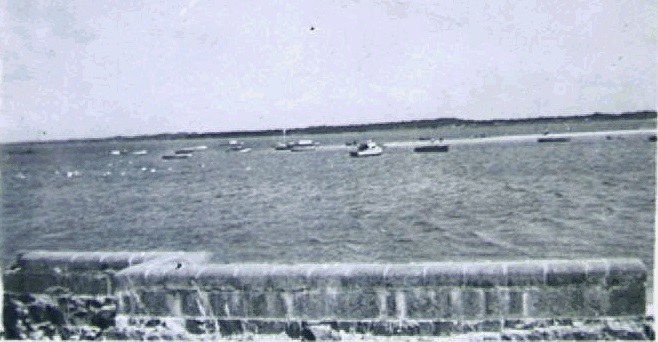
Then as a sand spit (The Point) developed, the water between it and the wall, our swimming beach, became weedy, then smelly and eventually stagnant.
The adults preferred to swim over the front in the channel and reluctantly we left the warmer, smelly backwater of “Stinky” to join them.
“Stinky”, more widely known as Toy’s Backwater, has now been reclaimed by sand and a diverse and interesting vegetation.
But there were a couple of seasons when we kids scarcely swam at the beach, preferring to tag along with bigger cousins and patronise the salt water pool at pine Lodge (our “oldies” could never comprehend why we’d go there instead of to the beach!). We’d walk through the front gates of this establishment, and dodge around past the guests’ accommodation, pay our 3 pence to Cal Wyeth in the ticket box and join all the other kids in the pool. Life guards or pool attendants were unheard of, as were changing rooms or toilets. In an emergency, there was always the toilets (dunnies) over the fence in the grounds of the Catholic Church! School swimming carnivals were held at Pine Lodge, too.
And the “lolly shops” – greasy chips from Azzopardi’s, home made icecream from the Tarax Bar (Nelsons ), a spider in Drowley’s Pier shop and a bag of mixed lollies from “old Hitchie”. Evenings at Briggs Carnival.- the Merry-go-round a bit tame but the flying horses too scarey! Calling for the mail at the post office “Is there any mail for Chambers, Foster, Hamilton, Bickerton, Campbell please?” And sometimes the list was longer! Going for the milk – morning and afternoon, for we had no fridge – across “The Flat”, up High St. and into Mrs Jakies, as we called her, sometimes right up to the back to the cowshed (Garden Cres. now) at other times to the dairy near the house. There were open-air theatres in different locations over the years; in the hollow on Beard’s block, beside Drowley’s Pier shop, around “the other end” next to Brown’s Kiosk, beside Newton’s garage. Any others ?.
The following parody, based on a poem by W.T. Goodge called “The Great Australian Adjective”, is how we, at No.10, regarded progress in December 1949 when THE ROAD was put in, changing forever our route to the beach.
Joe Chambers wrote this parody for our New Year’s Eve celebration of January 1950 – just one of the many poems he penned over the years. As kids we loved to hear the …… replaced by that great Australian adjective, as Joe recited, in the early hours of the morning.
A harrassed …… motorist drove
Downhill on Grandview …… Grove
His brow was damp and …… ruddy
All …… day he’d strived and stroved
In front he spied the …… beach
His brakes went on with …… screech
Would he turn back or …… should he
Pass Stirton’s into …… beach
Cling to the track like …… leach
The boldest driver in the …… land
He did not under-bloody-stand.
No second thought or …… study
He drove with ruthless …… hand,
Com-bloody-pletely into sand.
“I’m bogged”, the …… the sand rose …… higher.
His anger flared up like a fire.
“Now listen, every-bloody-body,
Who named this road’s a …… liar
To hell with the Woorayl …… shire”
Joe Poe, Jan 1st 1950
Memory is a subjective thing; not always historically accurate. Each of us has a different view of events.
About the authors:
Joe CHAMBERS was a resident of Wonthaggi with a very close connection to Inverloch which is outlined in this book.
Joe was a school teacher who began to lose his eyesight in early adult life a condition which progressed slowly but inexorably. When Joe was unable to teach mathematics he taught music.
With his wife Lyn , Joe collected the stories of the residents of Wonthaggi which they published in a number of books. They were foundation members of the Wonthaggi Historical Society..
Joe gave the inaugural address at the first meeting of the Inverloch Historical Society and it is this address which is published in this book.
Joe was a shining example to all who knew him and a role model for many patients facing blindness.
Bill GRIEVE is a member of the Inverloch Historical Society
He was born in England and came to Australia as a babe in arms, thus he just qualifies as a “Pommy”.
Born and bred in Wonthaggi, Ruth GLARE (nee Hamilton) is a third generation CHAMBERS and has enough scots ancestory to qualify for “Scotland Yard”.
She and her husband Peter, a grandson of “Bullocky” GLARE live in Inverloch and are both members of the Inverloch Historical Society
Title: Anderson Inlet, Inverloch: Scotland & Pommy Land – The Wonthaggi Connection
Authors: Joe CHAMBERS, Bill GRIEVE & Ruth GLARE
Produced by: Inverloch Historical Society, Inc 1999.
ISBN 1876594039
Copyright © September 1998. First Edition March 1999
This book is published as a tribute to our friend & colleague Joe Chambers who died 30th June 1998.
The Society has endeavored to ensure that the information contained in this book is correct at the time of publication. However, it cannot accept responsibility for mistakes in this book, whether negligent or otherwise. Comments should be forwarded to the Society at PO Box 46 INVERLOCH Vic 3996 for possible inclusion in future editions. The Inverloch Historical Society’s files are available and researchers and students are invited to access further information available from the Society.
Editors note: Index from original printed book has been excluded.
